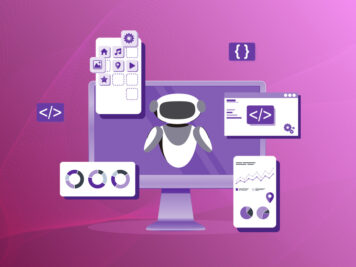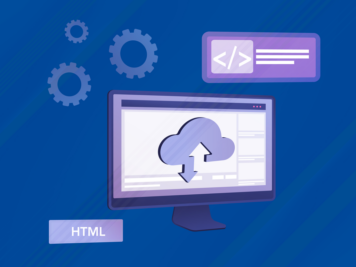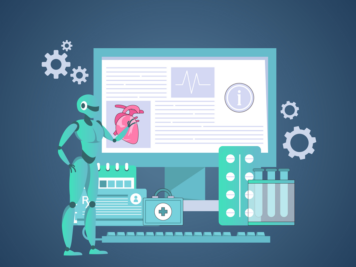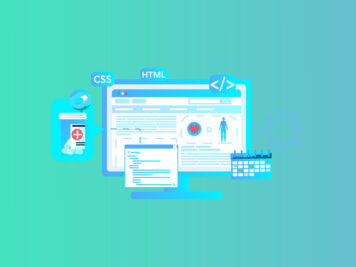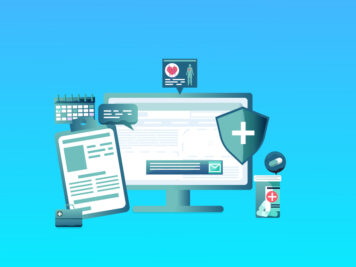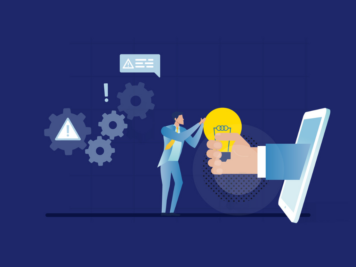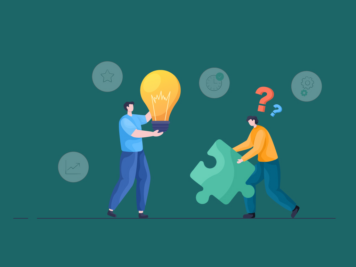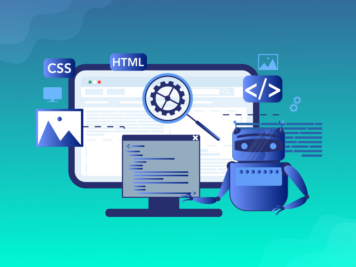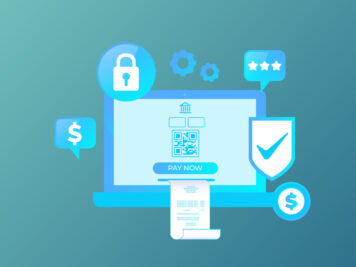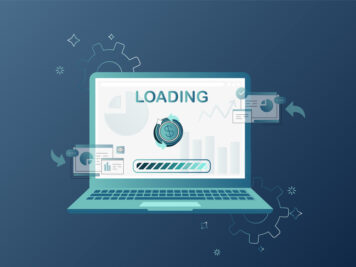Enterprise application modernization is on the verge of experiencing significant uptake. Foundry’s CIO study shows it’s a top priority for CIOs, and that makes perfect sense as in today’s digital world, apps are more than just tools; they are essential drivers of business success.
The good news is that application modernization technologies have advanced enormously. Enterprise Automation Platforms (EAPs) are no longer some basic add-ons. They are powerful platforms that can optimize operations while driving revenue through tailored automation solutions (Build use cases).
This shift, coupled with the emergence of generative AI, presents a tremendous opportunity. However, with so many options and approaches available, questions remain: how do I begin my enterprise application modernization journey? Which approach will be suitable for my organization?
Keep reading to find all the answers you need to make informed decisions and prepare your organization for a successful modernization journey.
What is enterprise application modernization?
Enterprise application modernization involves upgrading and improving outdated software programs to meet current business requirements and technology advancements. This method improves flexibility, scalability and performance, ensuring that applications are relevant and useful in today’s IT environment.
Check these signs why you need application modernization
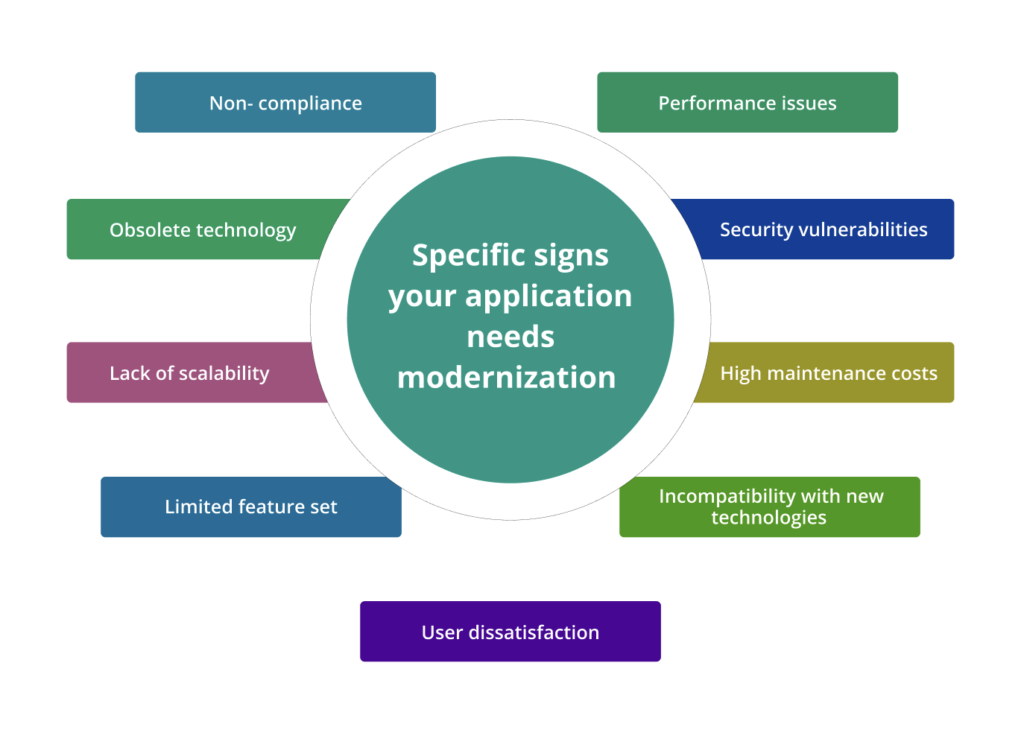
Specific signs your application needs modernization:
- Performance issues
- Security vulnerabilities
- High maintenance costs
- Incompatibility with new technologies
- User dissatisfaction
- Limited feature set
- Lack of scalability
- Obsolete technology
- Non- compliance
To determine, whether your current applications require an upgrade, you can se this checklist:
- Do your applications experience slow performance frequently? (Yes/No)
- Are your applications lacking modern security measures such as multi-factor authentication? (Yes/No)
- Do your applications struggle to integrate with newer technologies or systems? (Yes/No)
- Is a significant percentage of your IT budget spent on maintaining and updating legacy systems? (Yes/No)
- Can your applications handle more transactions during peak periods without crashing? (Yes/No)
- Do end users express dissatisfaction with application performance or functionality? (Yes/No)
- Is your existing technology stack considered obsolete? (Yes/No)
- Are your apps lacking features that your competitors have? (Yes/No)
- Does your application not meet current industry standards or regulatory requirements? (Yes/No)
Results:
Mostly Yes: it’s time to thoroughly evaluate and perhaps modernize your application.
Mostly No: your app can still serve its purpose, but it’s a good idea to make frequent evaluations and incremental improvements to ensure it remains relevant and effective.
The next step after checking these signs is to understand the substantial business benefits that enterprise application modernization can deliver.
Why should you consider investing in enterprise application modernization? The business benefits
Enterprise application modernization is important for many compelling reasons, each of which offers significant economic benefits:
Improved performance and efficiency
Modernized applications are designed to take advantage of the latest technological advancements, resulting in increased performance and efficiency.
For example, an updated inventory management system can speed up transaction processing, reduce downtime, and ensure real-time data accuracy, thereby optimizing supply chain operations.
Enhanced security
Legacy systems are often prone to security breaches, posing a major danger to critical business data. Modernizing your applications allows you to integrate powerful security features such as encryption, multi-factor authentication, and frequent security upgrades.
A study by Vercara reveals that around 75% of customers have shown readiness to sever ties with companies as an aftereffect of cybersecurity issues. A modernized customer relationship management (CRM) system is well-equipped to counter data breaches or identity theft attempts. They can help businesses retain users and attract new customers.
Cost savings
The initial investment in modernization is high, but in the long run, it can result reduce costs. Modern applications slash maintenance costs by cutting down the need for costly fixes and updates.
Take the example of optimizing resource allocation. Migrating an on-premises data storage solution to a cloud-based system is a great option to reduce hardware expenses.
Greater scalability
Enterprise application modernization enables seamless integration with cloud-native architectures and other scalable technologies. Transitioning to microservices simplifies scaling and enhances flexibility. Containerization streamlines deployment. For businesses aiming for growth, these practices effectively support higher user loads and data volumes while maintaining optimal performance. For instance, an e-commerce platform can handle sudden traffic spikes during peak shopping seasons or sales, ensuring customers have a seamless shopping experience.
Seamless integration
Modern applications are designed to work seamlessly with other systems and emerging technologies, creating a more interconnected IT environment. This integration feature allows for smooth data flow and increased cooperation between departments. For instance, combining a contemporary ERP system with sophisticated analytics tools can provide actionable insights that facilitate strategic decision-making.
Improved user experience
Primitive designs can distract users and lead them to opt for products that are more user-friendly. By redesigning user interfaces as a part of the modernization effort, product owners can turn their products into more intuitive and user-friendly.
Imagine an HR portal with two interfaces. One uses a traditional option-based system. The other features a bot that interacts with users using engaging templates. The second option is more appealing. It solves queries in fewer steps, making the experience faster and more interactive.
Compliance and adherence with regulations
Keeping up with regulatory changes is a challenge for businesses. Modern applications that can update themselves automatically to meet the current regulatory criteria can reduce the risk of non-compliance and subsequent fines.
Healthcare organizations and fintech companies can benefit from such systems that automatically update to meet new banking requirements, ensuring compliance.
Innovation and competitive advantage
Modernizing your applications can unlock new capabilities and functions that fuel innovation. Staying ahead of technical developments and implementing contemporary platforms helps your business maintain a competitive edge.
For example, adding generative AI into customer service applications can lead to personalized customer interactions, setting your business apart from competitors.
For deeper insights into key AI applications, challenges, and partner selection, read our dedicated article on Enterprise AI Solutions.
Business continuity and disaster recovery
Many modern programs offer powerful disaster recovery and business continuity features. These features ensure that your business operations can restart quickly after an unexpected interruption.
In fact, this is the idea that drove the development of a modernized data backup system that can provide real-time data replication and rapid recovery options. Such a system can reduce downtime in the event of a cyberattack or natural disaster.
Building your enterprise application modernization strategy: A 8-step approach
Step 1: Start by performing a comprehensive assessment of your current applications.
This evaluation should determine which applications are underperforming, outdated, or no longer aligned with business objectives. Use technologies like application performance monitoring (APM) software to collect information about performance and usage. Ask yourself:
- What are the current drawbacks and limitations of existing applications?
- How are applications performing in terms of speed, reliability and security?
- Which applications are critical to business operations?
Step 2: Clearly describe the business goals and objectives that modernization seeks to achieve.
Objectives should be consistent with the company’s broader strategy. Tools such as balanced scorecards can help in creating, tracking and managing your goals. Ask yourself:
- What specific business outcomes do we want to achieve through modernization?
- How would modernize applications benefit our long-term business strategy?
- What metrics will we use to determine success?
Step 3: Create a clear plan outlining the steps and timeline for modernization activities.
Prioritize applications based on their business importance and the complexity of their modernization. Tools such as project management software (e.g. Jira, Trello) can help plan and track progress. Consider questions:
- What is the timetable for each phase of modernization?
- Which applications should be prioritized based on business requirements and technological feasibility?
- What are the dependencies and risks?
Step 4: Choose the most appropriate modernization strategy for each application.
Use decision-making frameworks such as Gartner’s 5 Rs (Rehost, Refactor, Revise, Rebuild, Replace) to find the optimal option.
RehostRehosting, often called “lift-and-shift,” involves migrating applications from on-premises environment to the cloud with minimal changes. This method is best suited for applications that require little modification to function properly in a new environment.
The fundamental advantage of rehosting is its speed and simplicity, which allows businesses to immediately enjoy the benefits of cloud infrastructure features such as scalability, less maintenance and increased availability. However, rehosted applications may not fully utilize cloud-native features, limiting long-term efficiency benefits.
Refactor
Refactoring is the process of modifying the application’s code to improve efficiency, maintainability, and scalability while retaining essential functionality. This approach targets pain points, such as old libraries or inefficient code architectures, allowing applications to adapt to new IT settings.
Refactoring allows businesses to maximize resource utilization, increase system responsiveness, and simplify connection with other current systems. Although restructuring involves a greater investment of time and money than rehosting, it results in greater benefits in terms of application speed and flexibility.
Revise
Revising involves making significant changes to the design and coding of the application to better align it with current business requirements and technology improvements. This technique often involves modernizing the technology stack, introducing new features, and reorganizing critical components.
Revising is appropriate for applications that require significant changes to meet changing business requirements or utilize cutting-edge technology. Although this method can be complex and resource-intensive, it produces highly efficient applications that can support additional features and provide better user experiences.
Rebuild
Rebuilding an application means developing it from scratch. This method is used when existing applications are outdated, poorly built, or unable to meet future business expectations.
Rebuilding provides the opportunity to use new development frameworks, cloud-native architectures, and best practices, resulting in cutting-edge applications. Despite this strategy requiring a lot of time, effort and cost, the result is a new application with improved performance, stability and scalability.
Replace
Replacing refers to retiring existing applications with a new solution, sometimes off-the-shelf, which meets the same business needs. This method is useful when current applications are no longer capable of effectively supporting business operations or when superior business options exist.
Businesses can easily upgrade to feature-rich contemporary applications by replacing outdated systems, eliminating the complexity of maintaining or updating them. This strategy typically requires a major change management effort to achieve seamless integration and user adoption, but it can lead to rapid improvements in functionality and operational benefits.
Step 5: Determine which tools and partners will best help you achieve your modernization goals.
Consider systems with AI and machine learning capabilities. Choose partners who have demonstrated modernization expertise and who can meet the specific demands of your organization.
A collaboration with qualified cloud service providers, application modernization consultants, and technology providers can complement your efforts. Use resources like cloud migration assessment services or application performance monitoring software to help guide and track progress.
Step 6: Choose the best technology stack to enable updated applications based on scalability, security, and maintainability.
Cloud-native services like AWS Lambda or Azure Functions for serverless computing, containerization technologies like Docker or Kubernetes, and development frameworks like ReactJS or AngularJS can help you create scalable and responsive user interfaces.
Step 7: Execute modernization initiatives according to the roadmap
Execute the modernization strategy with minimal disruption to existing operations. Use agile approaches and advanced DevOps tools (such as Jenkins, Docker, and Kubernetes) to accelerate the deployment process and ensure continuous integration and delivery. But address these questions first:
- What specific procedures are required to update each application?
- How will we minimize disruption to business operations throughout the transition?
- What are the roles and responsibilities of team members throughout the implementation?
Step 8: Monitor, optimize and maintain.
After modernization, regularly monitor the performance of modified applications with APM tools (e.g., Dynatrace, New Relic) to find opportunities for further improvement. Regular updates and maintenance ensure that applications are both efficient and secure.
This 8-step approach allows organizations to successfully manage the complexities of enterprise application modernization. It ensures their applications are well-equipped to meet current and future business needs.
Measuring success, what metrics matter?
To evaluate the performance of your modernization initiatives, consider the following metrics:
| Category | Description | Metrics | Tools |
| Performance | Evaluate the performance of modernized applications under real-world circumstances. | Response time, throughput, and latency | Tools like Apache JMeter and Gatling can be used to simulate load and evaluate performance in various scenarios. |
| UX | Determine how end users interact with the new system. | User satisfaction, task completion, and error rates | Usability testing tools, user feedback, questionnaires, CSAT surveys, NPS surveys |
| Operational | Measures the impact on company operations. | Downtime, deployment frequency, and incident response time. | DevOps technologies such as Jenkins and PagerDuty. |
| Cost | Consider the financial ramifications of your modernization activities. | ROI,TCO and ongoing operating expenses. | Financial modeling tools. |
| Security | Make sure modernization does not compromise security. | Number of vulnerabilities discovered and fixed, encryption strength, and compliance status. | Nessus and Qualys |
| Scalability and flexibility | Evaluate the ability of applications to evolve and adapt to new requirements. | Resource utilization, horizontal scalability capabilities, and flexibility. | Google Cloud’s AutoML and AWS Auto Scaling. |
By meticulously recording and evaluating these metrics, businesses can gain deep insight into the performance of their application modernization projects and areas for improvement. Regular evaluations and modifications based on these results ensure that business goals and technical improvements remain aligned.
9 key enterprise application modernization and migration trends to watch in 2025 and beyond
Here are the top application modernization and migration trends that are influencing how businesses drive competitive advantage, improve user experience, and fuel innovation.
1. Integration of AI and ML
Modern workplace applications rely heavily on artificial intelligence (AI) and machine learning (ML). These technologies allow computers to learn and make decisions on their own, improving their capabilities such as customer service and fraud detection.
Integrating AI and ML into applications improves operational efficiency and automation. According to 80% of IT decision-makers, upgrading existing systems is essential to maximizing the potential of AI and ML.
2. Cloud native development
Migrating existing applications to the cloud provides immediate benefits such as flexibility and pay-as-you-go pricing. However, the real benefit lies in using cloud-native development. It involves the development and deployment of applications using cloud technologies such as containers, microservices, and cloud-hosted services.
Cloud-native applications can easily grow and adapt to changing business demands. Industry analysts expect that by 2028, almost all new digital projects (50%) will use cloud-native platforms, highlighting the importance of this trend.
3. Low-Code, No-Code (LCNC) development
LCNC platforms allow non-technical people to build software applications using simple drag-and-drop interfaces instead of sophisticated code. These tools accelerate application development, reduce expenses, and democratize technology, allowing enterprise users to build solutions without relying on expensive programmers.
The global LCNC platform market is expected to reach $190.79 Billion
by 2030, demonstrating its relevance in digital transformation.
4. Containerization
Containerization using tools like Docker and Kubernetes will become increasingly common as businesses value scalability and flexibility.
5. Microservices architecture
Microservices architecture has become popular among companies who work to break down monolithic applications into smaller, more manageable components.
6. Serverless Computing
With serverless computing, developers can focus on creating code rather than worrying about maintaining infrastructure. This trend is expected to increase as cloud providers expand their serverless offerings.
7. Hybrid cloud technology
Hybrid cloud computing combines public and private clouds to meet business demands more efficiently. This technique provides full control of data while leveraging the scalability of the cloud.
A well-implemented hybrid cloud strategy is important for effective digital transformation, according to 71% of IT leaders. As modernization efforts evolve, hybrid cloud solutions will continue to play an important role.
8. Progressive online apps
PWA combines the features of online and native apps, giving users the best experience of both worlds. They work in browsers but offer features like offline access and fast loading, ensuring a consistent user experience across devices.
PWAs are becoming increasingly popular due to their lower development costs than native apps.
9. DevOps Methodology
DevOps is a collaborative software development and operations strategy that aims to shorten release cycles and increase efficiency. Organizations that implement DevOps principles can accelerate application modernization, automate testing, and quickly release upgrades.
This adaptability enables rapid adaptation to changing business requirements and ensures timely delivery of high-quality applications.
Enterprise application modernization made easy: Key considerations and best practices
- Start small: Start with a pilot project to test the waters and improve your strategy.
- Focus on user experience: Make sure modernized applications provide a smooth and intuitive user experience.
- Take advantage of cloud services: Use cloud platforms to increase scalability and integration.
- Prioritize safety: Implement strong security procedures to protect sensitive information.
- Continuous improvement: Modernization should be seen as a continuous process, with the aim of constantly optimizing and innovating.
Conclusion for enterprise application modernization
Enterprise application modernization is important to stay competitive and future growth. You can turn your legacy systems into powerful engines of innovation by carefully assessing your needs, choosing the right strategies, and collaborating with the right tech partner.
With over 21 years of experience, we have developed complex tech products for startups and leading enterprises. We can help you in your application modernization journey too.
Contact us today to discuss your specific needs.
